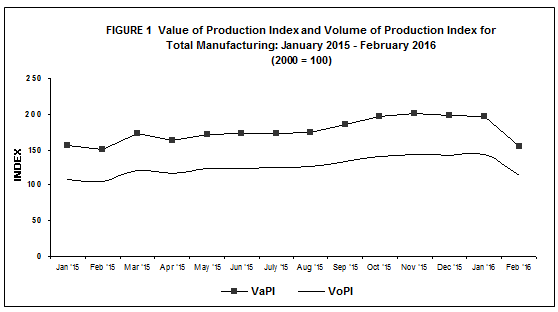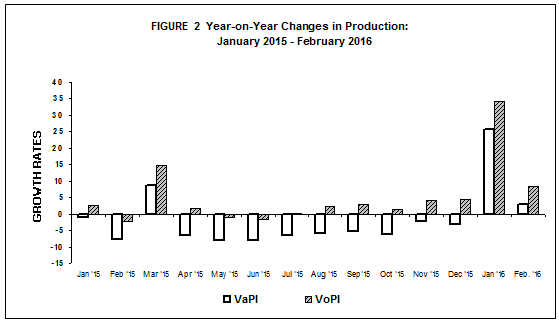|
Table A Year-on-Year Growth Rates for Production Index, Net Sales Index
and Producer Price Index: February 2016 and February 2015
|
||
|---|---|---|
|
TOTAL MANUFACTURING |
FEBRUARY
2016
|
FEBRUARY
2015
|
|
Production Index (2000=100) |
|
|
|
Value (VaPI) |
2.8 |
-7.6 |
|
Volume (VoPI) |
8.4 |
-2.1 |
|
Net Sales Index (2000=100) |
|
|
|
Value (VaNSI) |
-3.5 |
-10.5 |
|
Volume (VoNSI) |
1.8 |
-5.1 |
|
Producer Price Index (2000=100) |
-5.2r |
-5.6 |
r - revised
- Value of Production Index grows at a slower rate in February 2016
Value of Production Index (VaPI) for total manufacturing modestly grew by 2.8 percent in February 2016 compared with the negative 7.6 percent during the same month last year, according to the preliminary results of the Monthly Integrated Survey of Selected Industries (MISSI). The increases in 11 major sectors pulled up the VaPI. Of these, four major sectors exhibited two-digit growth, namely: fabricated metal products (27.2%), food manufacturing (25.8%), printing (22.8%), and furniture and fixtures (13.2%). The printing and furniture and fixtures industries recovered following six and thirteen consecutive months of decline, respectively. Refer to Tables 1-A and 1.
- Volume of Production likewise accelerates
Volume of Production Index (VoPI) posted a year-on-year increase of 8.4 percent from a 2.1 percent decrement in February 2015. Significant increases were noted in eight major sectors namely: furniture and fixtures (32.4%), food manufacturing (26.0%), rubber and plastic products (25.6%), fabricated metal products (24.7%), machinery except electrical (22.8%), printing (22.4%), non-metallic mineral products (19.8%) and electrical machinery (16.3%). Refer to Tables 1-B and 2.


- Value of Net Sales Index slides at slower rate
Value of Net Sales Index (VaNSI) reflected an annual drop of 3.5 percent in February 2016 compared with the two-digit decrease of 10.5 percent during the same month last year. This was primarily due to the slump in VaNSI observed in seven major sectors, offsetting the growth reported by 13 major sectors. Major sectors that reported two-digit decreases were basic metals (-25.1%), petroleum products (-24.9%), chemical products (-17.7%), furniture and fixtures (-17.1%), and footwear and wearing apparel (-15.6%).
Meanwhile, VaNSI for printing (62.3%) and fabricated metal products (30.6%) posted strong growths. Refer to Tables 2-A and 3.
- Volume of Net Sales Index posts positive rate
Volume of Net Sales Index (VoNSI) exhibited a positive growth rate registering at 1.8 percent in February 2016. The growth was mainly due to the improved performance of 13 major sectors, with significant increases noted in nine major sectors led by printing (61.8%) and wood and wood products (33.2%). Other significant increases were reported by the following: fabricated metal products 28.0%), tobacco products (25.9%), machinery except electrical (19.2%), miscellaneous manufactures (16.6%), rubber and plastic products (13.4%), paper and paper products (11.6%) and food manufacturing (11.2%). Refer to Tables 2-B and 4.

- Average Capacity Utilization Rate in February 2016 is 83.3 percent with basic metals posting the highest among industries
Average capacity utilization rate in February 2016 for total manufacturing was recorded at 83.3 percent. Fifty-five percent or 11 of the 20 major industries operated at 80 percent and above capacity utilization rates. These were:
- basic metals (88.3%)
- petroleum products (88.0%)
- non-metallic mineral products (86.3%)
- machinery except electrical (85.2%)
- food manufacturing (84.7%)
- electrical machinery (84.4%)
- paper and paper products (83.2%)
- chemical products (83.0%)
- rubber and plastic products (82.5%)
- wood and wood products (80.7%)
- printing (80.4%)
The proportion of establishments that operated at full capacity (90% to 100%) was 24.3 percent in February 2016. About 57.7 percent of the establishments operated at 70 percent to 89 percent capacity while 18.0 percent of the establishments operated below 70 percent capacity. Refer to Table 6 and B.
|
Table B Distribution of Key Manufacturing Establishments by Capacity Utilization for Total Manufacturing: February 2016 |
|
|---|---|
|
Capacity Utilization |
Percent Share |
|
Below 50% |
3.7 |
|
50% - 59% |
4.5 |
|
60% - 69% |
9.8 |
|
70% - 79% |
22.9 |
|
80% - 89% |
34.8 |
|
90% - 100% |
24.3 |
- Industry Coverage
The 2016 MISSI utilizes the 2009 PSIC to classify major industries and sub-industries. Twenty major industries of the 2009 PSIC were formed to comprise the industry coverage of the 2015 MISSI. These are presented in the table below.
|
2009 PSIC CODE |
INDUSTRY DESCRIPTION |
|---|---|
|
C10 |
Food manufacturing * |
|
C11 |
Beverages |
|
C12 |
Tobacco products |
|
C13 |
Textiles* |
|
C14, C152 |
Footwear and wearing apparel |
|
C151 |
Leather products |
|
C16 |
Wood and wood products* |
|
C17 |
Paper and paper products |
|
C18 |
Printing |
|
C19 |
Petroleum products* |
|
C20,C21 |
Chemical products* |
|
C22 |
Rubber and plastic products* |
|
C23 |
Non-metallic mineral products* |
|
C24 |
Basic metals* |
|
C25,C3311 |
Fabricated metal products |
|
C262,C275,C28, C263,C268,C3312,C332 |
Machinery except electrical* |
|
C261,C264,C27, C29301,C3314,C332 |
Electrical machinery* |
|
C29 except C29301, C30,C3315 |
Transport equipment |
|
C31 |
Furniture and fixtures |
|
C265,C266,C267,C32, C3313,C3319 |
Miscellaneous manufactures |
|
Note: * - Major industries categorized into sub-industries |
|
- Response Rate
The response rates for the February 2016 MISSI and PPS are 71.2 and 76.9 percent, respectively. Refer to Tables 7 and 8.
|
Table C Response Rates for Total Manufacturing
(In percent)
|
||
|---|---|---|
|
|
January 2016 |
December 2015
(Revised)
|
|
MISSI |
71.2 |
82.3r |
|
PPS |
76.9r |
84.2r |
r -revised
Data of non-responding samples were estimated using short-term geometric mean of the relative values of responding samples within the industry class. Revisions to the preliminary estimates are done upon receipt of actual reports of late respondents.
FOR THE NATIONAL STATISTICIAN:
TABLE 1-A Value of Production Index, January 2016 and February 2016
(2000 =100)
|
Gainers |
Year-on-Year Growth (%) |
|
|---|---|---|
| February 2016 |
January 2016
(revised)
|
|
|
Food manufacturing |
25.8 |
16.4 |
|
Electrical machinery |
8.3 |
5.0 |
|
Machinery except electrical |
9.1 |
4.3 |
|
Fabricated metal products |
27.2 |
-2.6 |
|
Printing |
22.8 |
-8.7 |
|
Transport equipment |
3.1 |
-6.9 |
|
Tobacco products |
6.8 |
8.3 |
|
Furniture and fixtures |
13.2 |
-38.7 |
|
Miscellaneous manufactures |
3.8 |
0.6 |
|
Beverages |
1.3 |
12.2 |
|
Rubber and plastic products |
1.5 |
0.9 |
|
Losers |
Year-on-Year Growth (%) |
|
|---|---|---|
| February 2016 |
January 2016
(revised)
|
|
|
Petroleum products |
-20.4 |
-33.8 |
|
Chemical products |
-21.8 |
307.1 |
|
Basic metals |
-27.6 |
-31.6 |
|
Textiles |
-21.3 |
-12.4 |
|
Footwear and wearing apparel |
-9.9 |
-4.9 |
|
Non-metallic mineral products |
-8.0 |
-5.4 |
|
Leather products |
-80.2 |
-80.0 |
|
Wood and wood products |
-16.3 |
-31.5 |
|
Paper and paper products |
-3.2 |
-11.3 |
TABLE 1-B Volume of Production Index, January 2016 and February 2016
(2000 = 100)
|
Gainers |
Year-on-Year Growth (%) |
|
|---|---|---|
| February 2016 |
January 2016
(revised)
|
|
|
Food manufacturing |
26.0 |
17.6 |
|
Electrical machinery |
16.3 |
19.4 |
|
Machinery except electrical |
22.8 |
18.9 |
|
Rubber and plastic products |
25.6 |
6.4 |
|
Non-metallic mineral products |
19.8 |
-7.1 |
| Fabricated metal products |
24.7 |
-2.9 |
|
Printing |
22.4 |
-7.2 |
|
Furniture and fixtures |
32.4 |
-27.5 |
|
Transport equipment |
5.6 |
-4.2 |
|
Tobacco products |
6.8 |
8.1 |
|
Miscellaneous manufactures |
0.6 |
-2.7 |
|
Losers |
Year-on-Year Growth (%) |
|
|---|---|---|
| February 2016 |
January 2016
(revised)
|
|
|
Petroleum products |
-10.5 |
-33.9 |
|
Basic metals |
-18.6 |
-22.0 |
|
Chemical products |
-6.1 |
309.1 |
|
Textiles |
-21.7 |
-12.5 |
|
Footwear and wearing apparel |
-7.2 |
0.2 |
|
Leather products |
-80.5 |
-80.3 |
|
Paper and paper products |
-5.5 |
-13.6 |
|
Beverages |
-1.4 |
9.3 |
|
Wood and wood products |
-8.9 |
-19.8 |
TABLE 2-A Value of Net Sales Index, January 2016 and February 2016
(2000 =100)
|
Gainers |
Year-on-Year Growth (%) |
|
|---|---|---|
| February 2016 |
January 2016
(revised)
|
|
|
Food manufacturing |
11.0 |
5.4 |
|
Printing |
62.3 |
1.4 |
|
Machinery except electrical |
5.8 |
2.6 |
|
Tobacco products |
25.9 |
16.3 |
|
Fabricated metal products |
30.6 |
8.0 |
|
Miscellaneous manufactures |
20.4 |
14.1 |
|
Non-metallic mineral products |
10.4 |
-0.3 |
|
Electrical machinery |
1.5 |
1.0 |
|
Paper and paper products |
14.3 |
7.2 |
|
Wood and wood products |
22.4 |
30.9 |
|
Rubber and plastic products |
8.6 |
9.0 |
|
Transport equipment |
0.9 |
2.5 |
|
Leather products |
7.6 |
108.7 |
|
Losers |
Year-on-Year Growth (%) |
|
|---|---|---|
| February 2016 |
January 2016
(revised)
|
|
|
Petroleum products |
-24.9 |
-13.6 |
|
Chemical products |
-17.7 |
317.1 |
|
Basic metals |
-25.1 |
-24.7 |
|
Footwear and wearing apparel |
-15.6 |
-12.4 |
|
Beverages |
-8.6 |
-4.5 |
|
Textiles |
-8.4 |
-6.5 |
|
Furniture and fixtures |
-17.1 |
-22.4 |
TABLE 2-B Volume of Net Sales Index, January 2016 and February 2016
(2000 =100)
|
Gainers |
Year-on-Year Growth (%) |
|
|---|---|---|
| February 2016 |
January 2016
(revised)
|
|
|
Food manufacturing |
11.2 |
6.5 |
|
Machinery except electrical |
19.2 |
17.0 |
|
Electrical machinery |
9.0 |
14.9 |
|
Printing |
61.8 |
3.0 |
|
Tobacco products |
25.9 |
16.1 |
|
Fabricated metal products |
28.0 |
7.8 |
|
Miscellaneous manufactures |
16.6 |
10.3 |
|
Non-metallic mineral products |
8.4 |
-2.1 |
|
Paper and paper products |
11.6 |
4.3 |
|
Wood and wood products |
33.2 |
53.3 |
|
Rubber and plastic products |
13.4 |
14.9 |
|
Transport equipment |
3.4 |
5.5 |
|
Leather products |
5.9 |
105.2 |
|
Losers |
Year-on-Year Growth (%) |
|
|---|---|---|
| February 2016 |
January 2016
(revised)
|
|
|
Petroleum products |
-15.6 |
-13.8 |
|
Chemical products |
-17.0 |
319.2 |
|
Basic metals |
-15.8 |
-14.3 |
|
Beverages |
-11.0 |
-6.9 |
|
Footwear and wearing apparel |
-13.1 |
-7.7 |
|
Textiles |
-8.9 |
-6.6 |
|
Furniture and fixtures |
-3.1 |
-8.3 |
